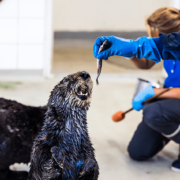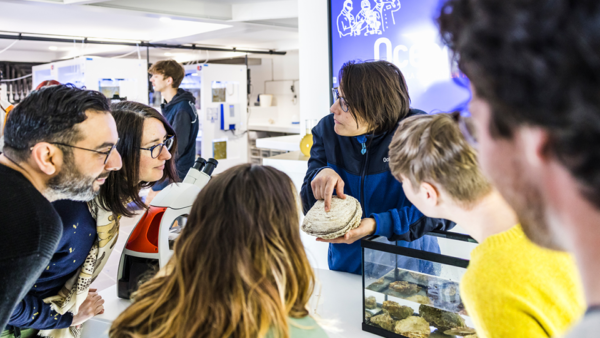A scientific mediator will help you discover different areas usually innacessible to the public.
News
Summer special : little People of the Sea

From July 8 to September 3, dive in and meet the ‘Little People of the Sea’. Marvel at the incredible diversity of animals and plants that inhabit Brittany’s foreshore.
SUMMER SPECIAL: LITTLE PEOPLE OF THE SEA
This summer, we are taking you on a journey to discover the amazing universe of small marine organisms that inhabit Brittany’s foreshore. This part of our biodiversity is often overlooked but plays an essential role in the balance of marine ecosystems.
Using a camera submerged in an aquarium, a standard microscope and a stereo microscope, a scientific mediator will help you discover the extraordinary adaptations of seaside plants and animals live on a big screen.
These visual tools will allow you to observe in detail and get a fresh look at the flora and fauna living in their sometimes extreme environments.
How does seaweed survive at low tide?
Why do clingfish have a sucking disc?
What is the secret of flatfish hiding in the sand?
You will get a complete insight into Botryllus species, sea anemones, barnacles and other inhabitants of this coastal ecosystem. Their secrets will be secret no more!

12:30 pm and 3:30 pm

3D PLANKTOLOGY
Enjoy a dynamic 3D immersion on the big screen and explore animal and plant planktonic organisms with the help of a scientific mediator. From viruses and bacteria to salps, Physalia and copepods, the ocean is home to a multitude of discreet but nevertheless fascinating creatures.
Under major threat from pollution, climate change and ocean acidification, these animals and plants nevertheless play an essential role in our oceans. Indeed, they are involved in climate regulation processes, including CO2 consumption and carbon sequestration in deep seas.
DID YOU KNOW?
Oceans are home to a multitude of organisms that float and drift with the currents.
This multitude of organisms are known as plankton, which for the most part are invisible to the naked eye. Plankton represent more than 95% of our marine biomass and are home to an exceptional diversity: viruses, bacteria, microscopic algae, reproductive cells, fish larvae etc. Plankton vary in size from 0.0001mm for bacteria and viruses to more than a metre for some jellyfish.
Plankton play a vital role in the functioning of our oceans and the balance of our planet. They produce more than 50% of the oxygen in the air we breathe and help regulate the climate. They are also at the root of all food chains.

OCÉANOLAB
Ground-breaking and unique, the Océanolab programme was designed by Océanopolis working with the Université de Bretagne Occidentale’s European Institute for Marine Studies (IUEM). It seeks to bring scientists and citizens together based on marine ecology research projects in the context of climate change, pollution and the erosion of biodiversity. The objective of this ‘science in the making’ programme is to share with you, in real time, scientific work over the course of a year in a dedicated space within Océanopolis.
GUIDED VISIT
Within the 160m² occupied by Océanolab, meet the researchers, engineers and technicians of the scientific project in residence. Accompanied by a scientific mediator, you will be able to discover the usually secret world of laboratories.
Practical informations:
From July 8 to September 3, every day at 1:30 pm, 2:30 pm and 3:30 pm
Duration: 45 minutes
Location: Océanolab at Océanopolis’s entrance forecourt
From 8 years old – group of 30 visitors maximum
Access: Register at the Brittany pavilion’s reception desk
SUMMER SPECIAL AND UNACCOMPANIED TOUR
Thanks to equipment comprising a stereo microscope, standard microscope and a tank with an underwater camera, discover live in the presence of a scientific mediator the scientific experiments in progress at Océanolab.
Practical informations:
From July 8 to July 13, every day from 4:30 pm to 6 pm
From July 14 to August 25, every day from 10:30 am to 12:30 am and from 4:30 pm to 6 pm
From August 26 to September 3, every day from 4:30 pm to 6 pm
Duration: 15 minutes
Location: Océanolab at Océanopolis’s entrance forecourt
From 8 years old – group of 35 visitors maximum
EVERYTHING YOU NEED TO KNOW’ SESSIONS
Boost your knowledge about the different species presented at Océanopolis.
Every day from July 8 to September 3. Duration : 20 minutes – For all
- Everything you need to know about penguins
Discover 3 species: king, gentoo and rockhopper penguins. These funny birds, inhabitants of the South Pole, have particular customs and adaptations allowing them to resist the harshness of the Antarctic climate.
Hours: 10:45 am and 3:45 pm – Location: Polar pavilion penguin enclosure
- Everything you need to know about seals
Meet our scientific mediator at the Brittany pavilion seal beach and learn more about the species of seals encountered in Brittany and their essential roles in the marine ecosystem.
Hours: 11:15 am and 3 pm – Location: Brittany pavilion seal’s beach
- Everything you need to know about otters
Sea otters are the most aquatic of all otters and are the only ones that can live permanently in the sea. An Océanopolis mediator will help you discover the many facets of these amazing creatures. Meet Pukiq, Matchaq and Tangiq, our ambassadors of the North Pacific!
Hours: 1:30 pm – Location : Otter’s trail
- Everything you need to know about seaweed
Brittany’s waters are among the richest and most diversified in the world, with more than 700 species of algae recorded! These marine plants often intrigue swimmers in the summer. Beyond their essential ecological role, marine macroalgae have many interesting properties for food and industry.
Hours: 2:15 pm – Location: In front of the Brittany pavilion’s kelp aquarium.
- Everything you need to know about cold-water corals
Corals don’t only live in the tropics. There are also cold-water corals that grow at depths of several hundred metres off the coast of Brittany. Thanks to hyperbaric aquariums, scientists from Ifremer’s ARDECO research project have sought to understand the response of cold-water corals to the warming and acidification of ocean waters in order to help preserve these key organisms in our deep oceans.
Hours: 4:30 pm – In front of the Brittany pavilion’s AbyssBox.
- Everything you need to know about sharks
Which species of sharks and rays can be found at Océanopolis? How do we feed them? Do they reproduce? What is the difference between a shark and a ray? During these sessions, discover both tropical and temperate species through some of Océanopolis’s most iconic fish: zebra and white tip sharks, sawfish, eagle rays and grey reef sharks.
Hours: 5:15 pm – Location: In front of the tropical pavilion’s shark aquarium.
Events in the brittany pavilion Minilab
Discover 4 playful and interactive animations about Brittany’s marine biodiversity alongside an Océanopolis scientific mediator.
Duration: 30 minutes – Location: Brittany pavilion’s Minilab – Age: from 6 years old
- In a drop of water
Incredible life in a single drop of seawater! Using a microscope, binocular magnifying glasses and 3D-printed models, the scientific mediator provides a live discovery of the extraordinary forms of plankton, its role and its importance in marine ecosystems.
From July 8 to July 13: at 11 am and 3 pm – From July 14 to August 25: at 11 am, 3 pm and 6 pm – From August 26 to September 3: at 11 am and 3 pm

- Quiz : ‘Do you really know sharks?’
Did you know that some species have up to three eyelids? That a white shark can detect a drop of blood in the volume of water found in an Olympic swimming pool? Or that the Greenland shark could live up to 400 years? Visitors can test their knowledge and discover some unusual information on rays and sharks at the Minilab with an Océanopolis scientific mediator.
From July 8 to September 3: at 12 am and 5 pm
- Treasures of the foreshore
At high tide, the sea deposits a strand of seaweed mixed with unusual objects on the beaches: this is the foreshore. Cuttlefish bones, the remains of shells, the hard shells of sea urchins but also pieces of plastic. Where does this debris come from? What is the role of the foreshore? Discover with the scientific mediator many testimonials about biological activities and the significant exposure to pollution in this little-known yet essential area.
From July 8 to July 13: at 2 pm and 4 pm – From July 14 to August 25: at 10 am, 2 pm and 4 pm – From August 26 to September 3: at 2 pm and 4 pm

Exhibition: what oceans for tomorrow ?
MARINE ECOSYSTEMS FACING CLIMATE CHANGE
Inspired by the work of the IPCC, in particular the 6th report published in 2023, Océanopolis and the Ocean & Climate Platform are curating this exhibition illustrating the connections between oceans, biodiversity and climate.
The exhibition warns of the vulnerabilities of the marine environment and sheds light on the solutions it can provide for adaptation, mitigation and sustainable development, through the photographs taken by CNRS researcher Erwan Amice.
© Erwan Amice
The largest living space on earth, our oceans cover more than two-thirds of the planet’s surface area. Oceans are a real climate regulator, and have absorbed almost a third of greenhouse gas emissions and 90% of the heat produced by human activities since the start of the industrial revolution.
Oceans are also home to a wide variety of ecosystems including coral reefs, mangroves, kelp forests and seagrass meadows which play a key role in the functioning of marine biodiversity. These environments, which have great cultural value for many communities, are sources of food, minerals, energy and jobs for human populations. However, climate change is exposing marine ecosystems to conditions unprecedented for millennia. This has a considerable impact on life in the oceans, alongside other human activities such as overexploitation of resources, pollution and coastal development.
As a result, the marine environment is increasingly less able to maintain the essential services it provides, particularly in terms of climate regulation. All living things, both at sea and on land, are being seriously disrupted. As the impacts of climate change accelerate and intensify, protecting marine ecosystems is all the more urgent.
Practical informations:
Dates: From July 8 until the end of 2023
Location: at Océanopolis’s entrance forecourt
COMPLETE YOUR VISIT
Enjoy a complete experience at Océanopolis by going behind the scenes on a guided tour or even become one of our keepers for the morning!




Healer for a day
Live an unforgettable moment discovering the animal trainer profession. A fun filled morning with guaranteed emotions
 Book a ticket
Book a ticket







 Commitment to shark and ray co...
Commitment to shark and ray co... 








